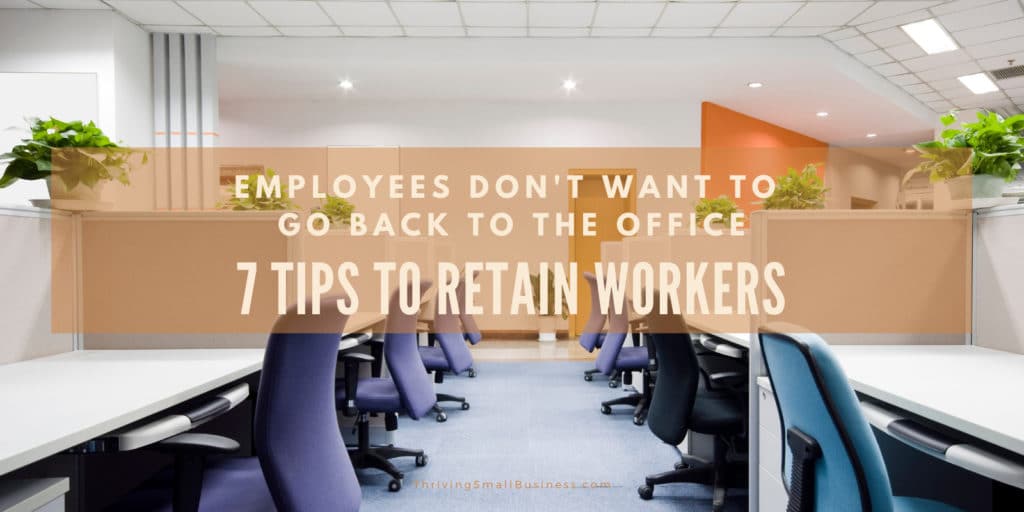Employees Don’t Want To Go Back To The Office – 7 Tips To Keep Them
Many businesses are finally getting employees back to the office after this long Pandemic period of working from home.
Unfortunately, many employees got used to working remotely, being available for their families, and enjoying the freedom that comes from virtual work.
A frightening survey revealed that as many as 40% of workers would consider quitting if they are forced to return to the office full-time.
Organizations are scrambling to figure out how to get employees back without losing them. This tender balance may be the difference between new recruiting efforts and maintaining flexibility for valued employees.
How To Retain Employees?
To understand how to retain employees, we must first understand why employees leave.
Why Employees Leave
According to a report from Achievers Workforce Institute, employees in 2021 are changing jobs for better compensation and benefits (36%), while work-life balance (25%) is the second-highest reason for employee defection.
Lack of recognition for their work comes in third place with (16%) of the workforce citing that as a reason to change jobs.
Why Employees Stay
However, when you consider why employees plan to stay with a current employer, the main reason is because of work-life balance (23%), followed by recognition for their work (21%), with compensation and benefits (19%) landing in the number 3 position.
There is already a severe worker shortage, and organizations need to manage employee turnover and focus on retaining employees. These efforts are important so employers don’t find themselves short of the help they need to get the job done.
There Is A Cost To Turnover
There is a cost to turnover that organizations need to consider as they try to maintain valuable employees.
For instance, the average cost to replace an employee is $4,500.
In addition to the cost associated with recruiting new employees, there is also work disruption, learning curves for new employees, team adjustments as new members join the group, and valuable tacit knowledge that walks out the door.
This means retaining current employees is simply a smart business practice.
“Of 2000 employees surveyed, 52% said
they will job hunt in 2021-Up from 35% in 2020! “
Achievers Workforce Institue
7 Tips To Retain Employees
1. Promote Work-Life Balance
Since work-life balance is the number one reason why employees stay, let’s talk about that first.
Personal well-being is imperative for happy, productive employees. Unfortunately, our personal lives can’t be checked at the door.
Life has gotten crazy for all of us. It seems like the wheels spin faster and faster.
Take that speed and throw in a couple of kids, an aging parent, a single parent, and you have an employee who is on overload.

Support employees by getting creative with scheduling flexibility, remote work, and condensed workweeks.
Use the new technologies that we have discovered during the Pandemic and allow employees to have more flexibility.
Model a balanced work-life and help employees juggle their personal responsibilities by providing them with the needed compassion and support for the very real-life issues they deal with.
2. Show Appreciation
Most employees go to work with the intention of doing a good job. Recognize these contributions and show your appreciation for all that employees do.
Get out, talk to employees, and thank them for doing their job. Show them appreciation, even if it’s simply a verbal thank you, a pat on the back, or a public acknowledgment of a job well done.
3. Begin Doing A Stay Interview
We are all familiar with an exit interview. However, organizations are now doing stay interviews to try and learn about the employee experience – before they leave.
The strategy is to learn from the employee and be proactive in retention.
This is done by helping workers understand the organization’s mission while getting employees involved in planning and giving them a voice in how work gets done.
4. Review Compensation Packages
At the end of the day, it always comes back to pay. When unemployment is low, employees know they have choices. They also have access to lots of pay data online, so they know what their job is worth.
Take the time to create a compensation strategy that focuses not only on pay but also on other benefits that can help retain a great employee.
This involves doing research to make sure your pay grades are competitive.
Also, benchmark health care, retirement, and paid time off practices of other like organizations to ensure your business can compete with the competition down the street.
5. Train Your Managers
Employees leave jobs more often because of their direct supervisor than any other factor.
People who are put in charge of employees need to know how to do their job.
It is a sad fact but all too often, businesses promote a great employee to a management role without providing them with the necessary training to do the job.
An end result is a person who does not know how to respond to the myriad of issues that a manager needs to deal with.
Be proactive and help employees when they transition to supervisor by training them and providing them with the necessary tools as they prepare for the very real issues that come with managing others.
“2 in 5 US workers say they are
actively looking for another job.“
6. Provide a Career Path
An astounding 21 percent of employees who leave a job do so because they didn’t feel like there was room to grow in their position.
Use your performance management system to identify professional strengths and developmental opportunities.
Utilize internal or external training to enhance skills. Ask employees to do a self-appraisal during their performance review process to identify their professional aspirations.
Then create a personalized plan to help employees achieve those career goals.
7. Talk To Employees
There seems to be a tendency for organizations to slow communication to employees when there seems to be nothing to say.
However, that is exactly when communication needs to increase. Employees want to know the state of the organization and how it is performing.
Take time to have open forum meetings and allow employees to ask questions and voice concerns. Give employees a confidential way to express their feelings by providing employee comment cards or an employee satisfaction survey.
I’m a firm believer that you can’t fix a problem if you don’t know it exists, and you can’t know about it unless you ask. Find out what the issues are and put a plan in place to get them resolved.
Show You Care
Managing employees is very similar to parenting in that the kids need to know they are valued and loved. Don’t neglect this very important aspect of employee retention.
Our economy is again booming, and almost anyone who wants a job is working. Organizations that can find and keep productive employees have a strategic advantage.
Pay attention to your employees, address their needs, and provide them with fair compensation so that your organization can retain the employees you will need to achieve corporate objectives.






